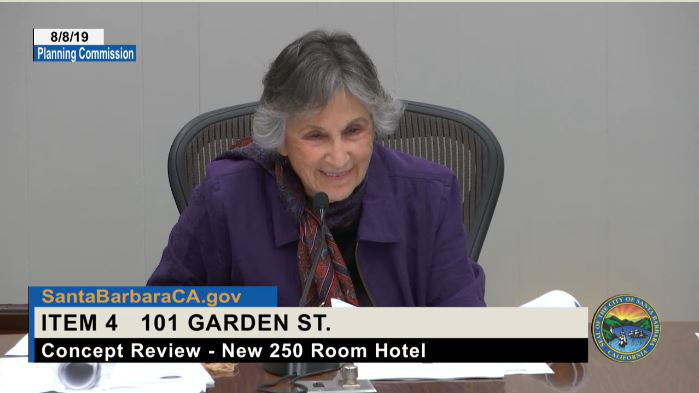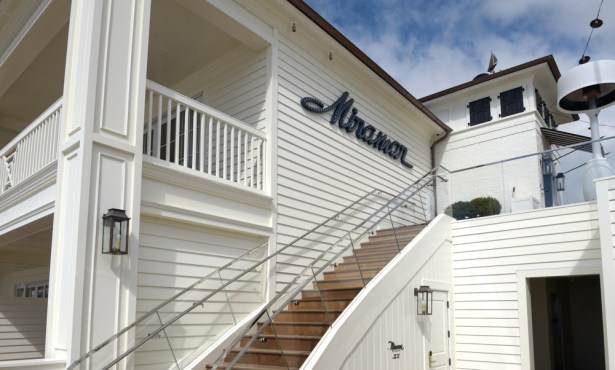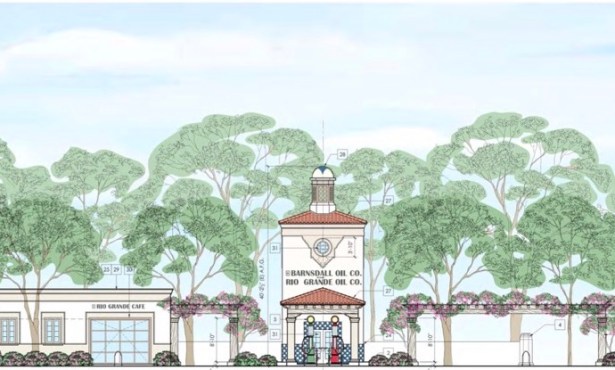How Many Rooms at the Inn? Asks New Waterfront Hotel
Planning Commissioners Answer: How About Building Homes Instead?

The new hotel proposed two blocks from the beach at 101 Garden Street got a look-see from the city Planning Commission yesterday that was only a conceptual review. But the commissioners and the public made it clear that the concept they wanted to see was housing, not hotel rooms. And others worried about another development in Santa Barbara’s coastal zone at a time of rising seas.
Thirty-six years ago, in 1983, property owner Bill Wright got permission from the city for a 250-room hotel on six lots along Garden Street between the railroad tracks and Yanonali Street. It’s also zoned “multi property residential.” The map drawn up was part of a Specific Plan document agreed to by Wright, who owns the four corners of Garden and Yanonali. At the time the area was part industrial yards and part hobo jungle, and Wright allowed the city to cross his properties to build out Garden Street to Cabrillo Boulevard and Yanonali Street east to the Laguna Channel, street extensions that were completed in 1997.
In one of those Santa Barbara moments, Planning Commissioner Sheila Lodge recalled signing the Specific Plan when she was mayor in 1983. She then gestured to Ken Marshall, in the audience representing planning consultant Dudek. He’d been involved in the environmental impact report that preceded the Specific Plan, she said to laughter from their colleagues over the implications to their respective years.
The nonbinding review on Thursday afternoon posed a number of questions to the commissioners from both city staff and the project applicants that had to do with the archaic document. That Wright has the absolute right to build a hotel was undisputed, but the issue of housing, specifically Santa Barbara’s lack of same, came from all corners of the room, including from a phalanx of international students in the audience.
Mid-presentation, about 17 youthful, sun-tanned people had filed into the room, fitting into three of the city-council chamber’s pew-like benches. One of them gave his two minutes to Roxana Bonderson, who then had four minutes to implore the commissioners to give serious thought to city housing which suffered serious shortages. When Lodge leaned over to ask her who her young friends were, Bonderson said they were international students who were, in fact, renting in town and she was their teacher. They’d been talking about local politics, she said, and were there to get some first-hand experience.

As the planning commissioners gave the project adherents their thoughts, Commissioner Michael Jordan suggested they dangle a project-approving carrot in the form of employer-sponsored housing, since a hotel would generate both low-income jobs and the collateral need for low-income housing. Planning Commissioner John Campanella opined this was one of the last two residentially zoned parcels in the Special Plan on this side of the highway and could the city afford to pass that up?
Project architect Brian Cearnal explained there was little likelihood that housing or a combination of housing/hotel rooms would be feasible. A national chain, engaged by project developer Michael Rosenfeld of the Hotel Californian, was interested in running a hotel there, but it considered 250 rooms a break-even sweet spot for business, which includes extended-stay rooms with full kitchens. The plans call for 131 moderately priced suites — mostly studios but 20 would have either one or two bedrooms. And in one of the complications of city zoning codes, the existence of kitchens throws the project into a residential zoning category that only allows 123 studios or 107 one-bedroom apartments.
Other issues arose over the preliminary drawings. City watcher Anna Marie Gott told the commissioners to notice the plans had no employee parking and that the hotel was likely to raise complaints of noise from the rooftop, as was happening at the Californian. Comments from commissioners about a compact roundabout opposite the hotel entrance — considered to be dangerously situated on Garden Street’s outside curve — included residents’ and visitors’ unfamiliarity with the circular devices and the ability of trucks pulling boats on trailers from the nearby boat yard to make it around. The last was resolved when traffic engineer Derrick Bailey said they could basically run over it.
The “wetlands,” to run along Garden below Yanonali, was favored, although the idea took much ribbing from Commissioner Addison Thompson for containing, currently, native species like shopping carts and abandoned bicycles rather than water. “It’s a ditch,” he chuckled, not a wetlands. However, the commissioners praised the plantings, trees, and small bridge at the corner as a welcoming entryway to the city and its waterfront.
The height called out for the hotel, three stories, or 45 feet (actually 48 feet including the elevator tower), is also allowed in the Specific Plan and generated little disagreement from commissioners. They told the project planners to remove the storage and entryway structures on the roof — which is added into the open space requirement — that would otherwise constitute a fourth floor, which is not allowed in the Specific Plan. Cearnal emphasized the third story was aligned north to south, with the sections along Garden and Yanonali streets stepped back to two stories, all to preserve mountain views from the waterfront. He added that the Historic Landmarks Commission, which had reviewed the drawings the day before, was uncertain that Monterey-style balconies belonged on a third floor, and he was rethinking the look of that section.
The other side of the hotel, its underside, will be about 10 feet below grade as most parking goes into a 228-space, below-ground parking garage. Parking, like the number of rooms, has its own series of rules and issues, and rooms generally dictate parking spaces. But a below-ground structure two blocks from the beach has the added complication of sea rise to consider.
Cearnal set the first floor of the hotel at 13.5 feet above the current surface to avoid ocean intrusion. The land itself, now hosting a hodgepodge of storage containers, roams from a high point of 15 feet at Yanonali to an average of 10 feet or so. The garage floor is about 10 feet below the hotel’s first floor, Cearnal explained, and about 3.5 feet above the land surface to avoid the water table. Commissioner Thompson questioned whether that might rise along with the sea by century’s end.
Santa Barbara’s guiding sea-rise study, which is currently in the review stages, posits a six-foot rise in ocean level by 2100 should the world fail to implement any and all preventive measures. If this worst-case scenario becomes the future, the sea-level-rise maps at the city vulnerability assessment website show a “blue blob,” as Marshall called it, at the property by 2100 from tidal inundation and, indeed, along the entirety of the waterfront. It would also be a block closer to the beach from shoreline erosion.
With the city continuing to be closed on alternate Fridays, a closure first implemented during the Great Recession, no clearer answers were forthcoming by the Independent‘s deadline on what that means for the depth of ocean likely at 101 Garden Street. Heal the Ocean founder Hillary Hauser, however, wrote a letter that cautioned the Planning Commission against any decisions on coastal zone development. “Sea Level Rise was not an issue in 1983,” said Hauser, “but it is now.”





You must be logged in to post a comment.